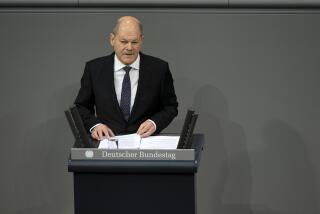PERSPECTIVE ON GERMANY : Sow the Fertile Ground of the East : The skills, resources and markets exist for a robust turnaround in the East, if nurtured and used wisely.
- Share via
FRANKFURT — As the unification of Germany progresses, the economic transformation of the old East is proving more complex than the early enthusiasts imagined. The industrial conglomerates, or kombinates, are particularly resistant to being turned around in the Western mold; indeed, many are unsalvageable, since they are committed by design to self-sufficiency, even at the price of efficiency. As we now can see, it is questionable whether Germany needs another steel plant east of Berlin, or a car designed and built entirely in the former eastern territory.
It would be tragic, however, if the skills of the workers employed in those sectors were no longer utilized. Attractive options exist, such as the production of automotive parts and components, whether under German, European, American or Japanese management. It is not car plants in the traditional sense (which often are nothing more than assembly facilities) but the manufacturing of parts and components that overwhelmingly accounts for the output of the entire industry.
We also need to put more stock in the strong suits of the already well-established economy. Small- and medium-sized companies may be a far better indicator of economic progress. They are a key ingredient of West Germany’s economic success and many of them export on a global scale. In the East German case, they provide an important source of new employment: Middle-of-the-road estimates predict the creation of 1.5 million jobs from this source alone over the next five years.
What about the services sector? What about our own experiences in the banking field? Deutsche Bank made a half-billion-dollar investment in about 150 bank branches in East Germany on July 1 and expects to reach the break-even point around the turn of the year. Even in the absence of an acceptable level of telecommunications and data-processing facilities, we have opened as many as 6,000 to 7,000 accounts a day.
And yet, skeptics are quick to cite a number of insurmountable problems. Accordingly, many misperceptions linger.
One comment often made is that the economy remains in trouble because banks cannot make loans in the absence of meaningful balance sheets, or at least a solid business plan. In fact, the situation is much like the early to mid-1950s when banks could also not go “by the book.” Under such circumstances, one simply has to develop an eye for the entrepreneurial talents of the loan applicant sitting across the table to determine whether he or she can actually carry a loan of 50,000 deutschemarks to buy two cabs, or considerably more to set up a small trucking company.
Another oft-cited issue is employee motivation. East Germans are supposedly reacting with indifference to the changed circumstances in the work place. In our business, however, we have found a very high degree of motivation among our 8,500 new employees, although most of them are former employees of the once sleepy state bank. Younger people especially are very willing to adapt to the free market. And virtually everybody responds favorably to the end of uniform pay. With pay based on performance rather than mere presence, there is a reason to work hard.
The salaries and wages we pay to our employees in the former East German territory average 50% of those in West Germany. Since the cost of living in the former has actually declined since the introduction of the deutschemark, that pay level is quite attractive. This should be good news to those who consider investing in Germany but worry about its high labor costs. The availability of locations for industrial sites and the skills of the work force also weigh in favorably. In addition, anybody willing to invest there can count on various tax incentives from Brussels or Bonn.
Other observers worry about the excessive costs of such a venture--which in light of the long-term benefits should more appropriately be termed an investment. While the outlays for a new infrastructure are certainly very large, they also need to be kept in proper perspective. East Germany, unlike all other East European countries, had little public debt. Therefore, even if one assumes the “real price tag” of German economic unification to reach a volume of 250 billion deutschemarks over the next three years, the country’s level of per-capita indebtedness would not rise above what it is today. So the message for the capital markets is this: While there may be more debt in absolute terms, the structure of public finance in Germany is going to stay the same. And there will be 16 million more taxpayers to meet that bill.
But the former East Germany needs more than money. Perhaps no task before us is more important than the transfer of know-how. For example, East Germany does not have a viable system of tax collection. Rather than officials from the finance ministry, what is truly needed are managers of local tax offices who have the experience to get basic day-to-day operations up and running. Advice has to be offered not so much from the top down but from the bottom up.
I know of a number of owners of carpenter shops or small construction companies who are engaged in joint venture in the East or render advice informally on issues such as where to buy materials, at what prices, and on which terms. In a place where marketing and purchasing skills are completely underdeveloped, their expertise falls on fertile ground.
Of course, one has to be very much aware of a delicate psychological balance in this effort of turning things around. Here again, we Germans face a challenge. We will have to watch the fine line that lies between offering advice and teaching with the proverbial index finger raised up high.
More to Read
Sign up for Essential California
The most important California stories and recommendations in your inbox every morning.
You may occasionally receive promotional content from the Los Angeles Times.













